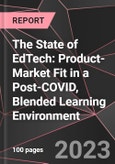The State of EdTech: Product-Market Fit in a Post-COVID, Blended Learning Environment” is approximately 28,000 words (100 pages). This report has implications for innovators, investors, educators, and learners, detailing ways to drive long-term positive change while securing more immediate product-market fit.
The objective of this report is to inform and inspire the EdTech community - including educators, policymakers, entrepreneurs, and investors - by synthesizing the views of innovators who are active across a wide range of EdTech segments and educational institutions.
In a post-pandemic blended learning environment, how can EdTech companies achieve product-market fit? The report aspired to answer this important question both qualitatively and quantitatively, by interviewing EdTech leaders and collecting then visualizing data that speaks to the frequent sector misalignment. This report provides diverse and unique insights into EdTech’s transformative potential, its dynamic trajectory amid the pandemic, and the possible risks and rewards of its evolution from here. The comprehensive analysis highlights the urgent need for holistic understanding, strategic planning, and thoughtful execution.
EdTech has the weighty task of nurturing the intellect and character of generations. When EdTech misses its mark, it doesn’t just result in an unused app or platform; it risks diminishing the potential of a child or even an entire classroom, campus, or district. It’s an almost sacred duty to provide learners with the tools they need not just to survive but to contribute meaningfully, understand the world critically, and navigate life’s challenges with resilience. Achieving product-market fit in EdTech is, thus, directly intertwined with the future generations we all hope for - well-equipped, purposeful, and compassionate individuals ready to build upon progress, correct past mistakes, and shape a better world. While speaking to these themes and leveraging top subject-matter expertise, the report also visualizes over 20 quantitative insights as infographics at the conclusion.
Report Highlights:
- The Need for Product-Market Fit: For tech startups, understanding the demands and limitations of the target audience is always crucial. In the EdTech space, this means being familiar with the evolving needs of students, parents, educators, and institutions. Incorporating continual feedback loops and iterating based on real-world applications will be instrumental. EdTech entrepreneurs can derive benefits by directly observing classrooms and consulting with teachers and administrators.
- Inherent Challenges: EdTech innovators must account for diverse educational needs, institutional norms, and societal ramifications. They must navigate technical, regulatory, and cultural issues. The education sector operates slower than the tech world, leading to potential tensions between stakeholders. Timing and planning alignment is crucial. The ultimate aim is a societal fit, where products meet the evolving needs of both learners and the larger community.
- Practical Over High-End: While the EdTech industry often targets high-end product development, schools often seek practical tools to tackle everyday challenges like grading and classroom management. As classroom sizes grow, there’s a corresponding demand for EdTech solutions to help manage larger groups and alleviate teacher workloads through technologies like automatic handwriting recognition and expedited grading. Established EdTech companies have also come to recognize the value of technologies that integrate effortlessly into education, ensuring that innovation aids rather than disrupts the learning process. Logitech, for instance, strongly believes in ergonomics and usability, having collected data to validate that this positively influences overall learning.
- Online and Blended Learning: The shift to online and blended learning models will likely continue beyond the pandemic. Institutions may see these models as opportunities to reduce costs, increase enrollment, and offer greater flexibility to students. However, care should be taken to ensure that the quality of education and socio-emotional skill development opportunities aren’t compromised.
- Accessibility, Flexibility, and Inclusivity: This involves accommodating diverse learning styles, facilitating asynchronous learning, and ensuring that students and educators can access and utilize tools effectively and equitably. Personalizing education to individual student needs is a much-discussed trend.
- Collaboration is Key: Partnering with educational institutions and the public sector is often paramount. Navigating procedures and bridging gaps can lead to EdTech growth. Technological advancements have precipitated new roles demanding agility.
- Navigating Digital Risks: Tech should enhance, not merely replicate, and certainly not replace, the holistic learning experience. Technology can amplify effective teaching but can’t compensate for poor teaching. The human element, including social connections and mental well-being, remains vital in education. The balance between analog and digital content remains an ongoing conversation topic. At the same time, the pandemic redefined perceptions of “essential” teaching tools and emphasized digital access as a human right. A massive funding influx helped to launch or expand many new platforms and tools, and those directly interfacing with educational institutions now must figure out where they stand in today’s and tomorrow’s education budgets.
- Bracing for Profound Change: For innovators, considering the broader EdTech ecosystem is critical. Providing support, upskilling educators handling deployments, and ensuring organizations have what they need to sustain digital progress will be integral to future EdTech growth trajectories. Additionally, the potential of AI to drive further interest in and exploration of alternative assessment methods could reshape educational practices and outcomes.
This report will provide answers to the following questions:
- How can EdTech providers best achieve product-market fit?
- What are popular views on blended learning environments?
- How has the pandemic impacted the reputation and viability of EdTech?
- Which areas of EdTech are being overlooked?
- What are the benefits and risks of gamification and other digital trends?
- What strategies and trends signify potential growth trajectories for EdTech?
Table of Contents
Companies Mentioned (Partial List)
A selection of companies mentioned in this report includes, but is not limited to:
- Habitat Learn Group
- Kami
- Labster
- Logitech
- PopUp School
- Saint Mark’s Episcopal School
- TITANS of CNC
- Tanjo AI
- Technovation
- University College London








